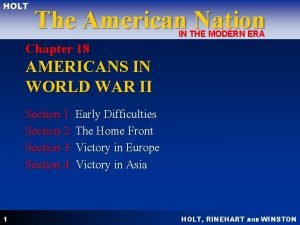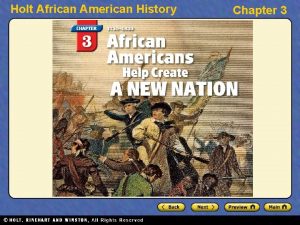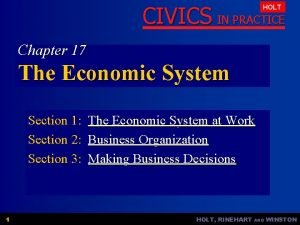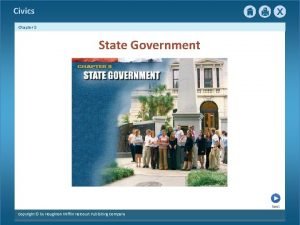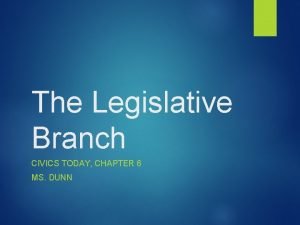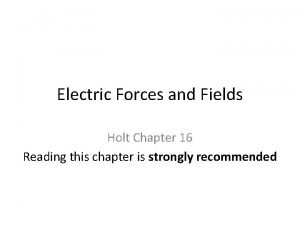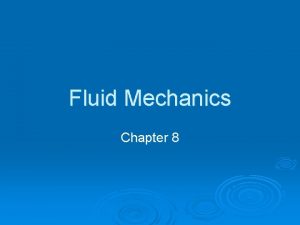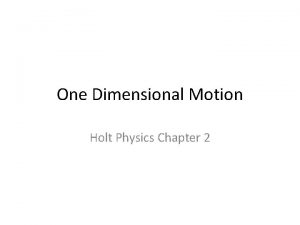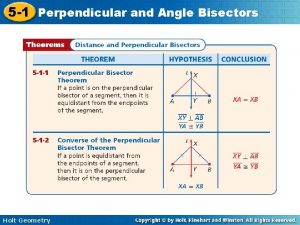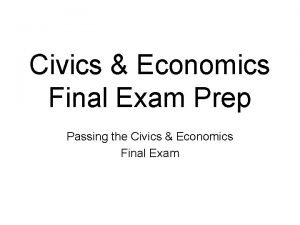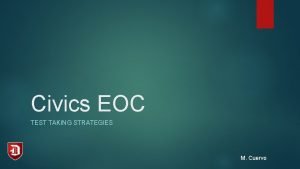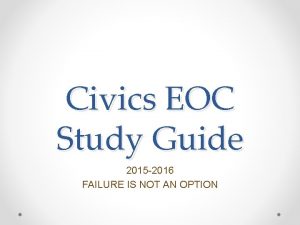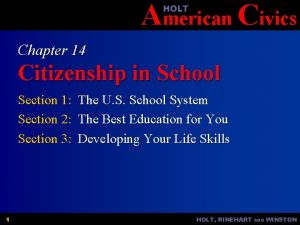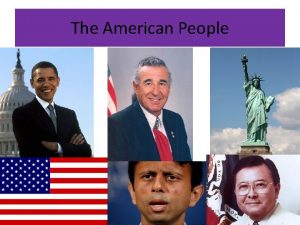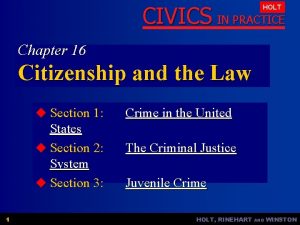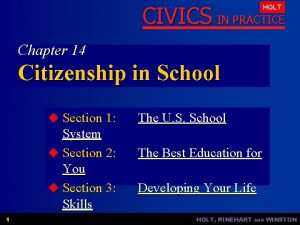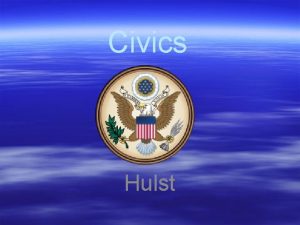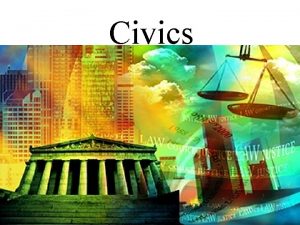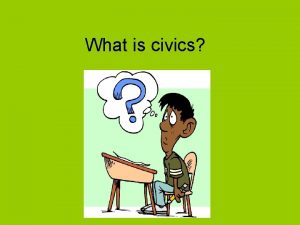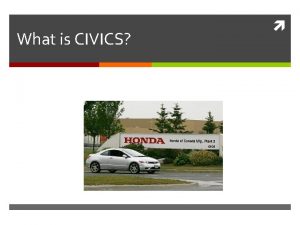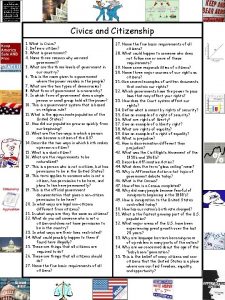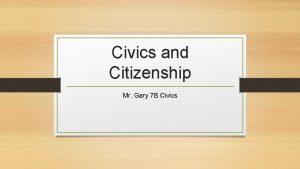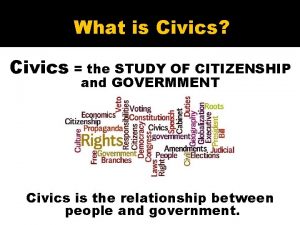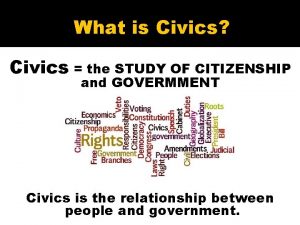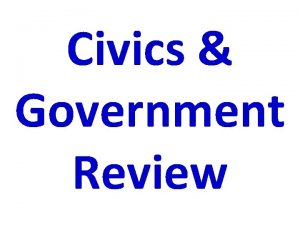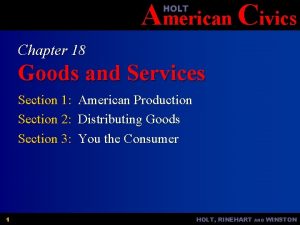American Civics HOLT Chapter 16 Citizenship and the

















- Slides: 17

American Civics HOLT Chapter 16 Citizenship and the Law Section 1: Crime in the United States Section 2: The Criminal Justice System Section 3: Juvenile Crime 1 HOLT, RINEHART AND WINSTON

American Civics HOLT Chapter 16 Section 1: Crime in the United States OBJECTIVES u What is the difference between a crime against a person and a crime against property? u What are some different types of crime? u What are some causes of crime, and how is crime fought? 2 HOLT, RINEHART AND WINSTON

American Civics HOLT Chapter 16 Section 1: Crime in the United States Crimes against persons: Violent crimes—homicide, hate crimes, aggravated assault, or forcible rape 3 HOLT, RINEHART AND WINSTON

American Civics HOLT Chapter 16 Section 1: Crime in the United States Crime against property: u The majority of crimes u Involves stealing or destroying property— petty larceny, grand larceny, vandalism, or arson u Robbery involves property and persons. 4 HOLT, RINEHART AND WINSTON

American Civics HOLT Chapter 16 Section 1: Crime in the United States Different types of crime: u Homicide, aggravated assault, forcible rape, larceny, u u 5 vandalism, arson, robbery Hate crimes—violent crimes committed because of prejudice Victimless—gambling and sale, possession, and use of illegal drugs White collar—committed by people in their work; stealing, embezzlement, and fraud Organized—a crime syndicate of career criminals; provides illegal goods and services; uses violence as a tool HOLT, RINEHART AND WINSTON

American Civics HOLT Chapter 16 Section 1: Crime in the United States Causes of crime: u Poverty u Illegal drug use u Permissive society u Urbanization 6 HOLT, RINEHART AND WINSTON

American Civics HOLT Chapter 16 Section 1: Crime in the United States Fighting crime: u 1994—National crime bill includes tougher sentences and grants for police officers and new jails. u Crime prevention education is taught in some schools. 7 HOLT, RINEHART AND WINSTON

American Civics HOLT Chapter 16 Section 2: The Criminal Justice System OBJECTIVES u What are the duties of police officers, and how do people become police officers? u What happens to a suspect after he or she is arrested? u How are criminals punished? 8 HOLT, RINEHART AND WINSTON

American Civics HOLT Chapter 16 Section 2: The Criminal Justice System Police Officers u Protect life and property, prevent crime, and arrest violators u Protect individual rights, maintain peace, and control traffic u Act as peacemakers, advisers, protectors, and community members 9 HOLT, RINEHART AND WINSTON

American Civics HOLT Chapter 16 Section 2: The Criminal Justice System Police Officers (continued) u Education, background check, aptitude tests, physical and psychological exams are required. u Academies teach law, community relations, gathering evidence, arrest procedures, records keeping, first aid, weapon use, and other physical skills. 10 HOLT, RINEHART AND WINSTON

American Civics HOLT Chapter 16 Section 2: The Criminal Justice System After a suspect is arrested: u Suspect is entitled to due process before questioning. u Preliminary hearing—evidence evaluated and charges u u 11 dropped or trial is set; bail set Indictment—a formal charge is made Arraignment—suspect makes a plea before a judge Trial—defendant is presumed innocent; a judge presides and a jury deliberates the case presented by the prosecution and the defense Sentencing—judge decides the punishment; some states have mandatory sentences for certain crimes HOLT, RINEHART AND WINSTON

American Civics HOLT Chapter 16 Section 2: The Criminal Justice System Punishing lawbreakers: u Fines u Imprisonment (People hold different views of its purpose: retribution, deterrence, rehabilitation, or social protection. ) u Parole (Early release based on good behavior; overcrowding has forced paroles. ) u Capital punishment (Opponents believe it violates the Eighth Amendment; it remains controversial. ) 12 HOLT, RINEHART AND WINSTON

American Civics HOLT Chapter 16 Section 3: Juvenile Crime OBJECTIVES u What are some possible causes of juvenile crime? u How has the judicial system changed the way it handles juveniles? u What happens when juveniles are charged and found guilty of breaking the law? 13 HOLT, RINEHART AND WINSTON

American Civics HOLT Chapter 16 Section 3: Juvenile Crime Possible causes of juvenile crime: u Poor home conditions u Poor neighborhood conditions u Gang membership u Dropping out of school and unemployment u Alcohol and drugs u Peer pressure 14 HOLT, RINEHART AND WINSTON

American Civics HOLT Chapter 16 Section 3: Juvenile Crime The judicial system has changed the way it handles juveniles: u Prior to late 1800 s—Juveniles at least seven years old were tried in adult courts and sentenced to prison or death. u 1870 s—Reformers argued juveniles required special understanding. u Juvenile court system was set up to re-educate offenders. 15 HOLT, RINEHART AND WINSTON

American Civics HOLT Chapter 16 Section 3: Juvenile Crime The judicial system has changed the way it handles juveniles: (continued) u Hearings determine guilt or innocence of juvenile offenders. u 1967—Supreme Court granted juveniles the right of due process. u Juveniles do not have the right to a jury trial. 16 HOLT, RINEHART AND WINSTON

American Civics HOLT Chapter 16 Section 3: Juvenile Crime Juveniles charged and found guilty u may be placed in a foster home. u may be sent to a corrections facility like a training school. u may be given probation. u may be sent to a boot camp. Juveniles charged with felonies are often tried in adult courts and punished accordingly. 17 HOLT, RINEHART AND WINSTON
 Holt american nation
Holt american nation Holt african american history
Holt african american history Civics in practice
Civics in practice Chapter 8 civics
Chapter 8 civics Bicameral meaning
Bicameral meaning Holt physics chapter 16 test
Holt physics chapter 16 test Buoyancy force in fluid mechanics
Buoyancy force in fluid mechanics In 1935 a french destroyer la terrible attained
In 1935 a french destroyer la terrible attained Holt geometry chapter 5
Holt geometry chapter 5 Civics and economics final exam study guide
Civics and economics final exam study guide Civics and economics definition
Civics and economics definition Token economy psychology
Token economy psychology Token economy in psychology
Token economy in psychology Sejarah perkembangan civics
Sejarah perkembangan civics Mr raymond civics eoc review
Mr raymond civics eoc review Civics sol review
Civics sol review Civics 360.org
Civics 360.org Civics eoc study guide
Civics eoc study guide
